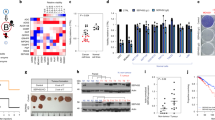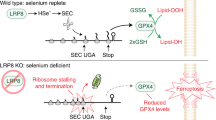Abstract
Epidemiological evidence has indicated an inverse association between selenium status and various types of cancer, including breast cancer. Selenoproteins are the primary mediators of selenium effects in human health. We have previously reported loss of heterozygosity in breast tumor samples of the gene for one of the selenoproteins, SELENOF. The function of SELENOF remains unclear and whether SELENOF levels impact breast cancer risk or outcome is unknown. The mining of breast cancer patient databases revealed that SELENOF mRNA is significantly lower in late-stage tumor samples and lower levels of SELENOF also predict poor patient outcome from breast cancer. Genetically manipulating SELENOF in human breast cancer cells or in the murine mammary gland by overexpression, silencing or knockout impacted cell viability by affecting both proliferation and cell death. Restoring SELENOF can attenuate a number of aggressive cancer phenotypes in breast cancer cells, including clonogenic survival, and enhance the response to drugs or radiation used in breast cancer therapy. Importantly, enhancing SELENOF expression reduced in vivo tumor growth in a murine xenograft model of breast cancer. These data indicate that SELENOF is a new tumor suppressor in breast cancer.
This is a preview of subscription content, access via your institution
Access options
Subscribe to this journal
Receive 50 print issues and online access
$259.00 per year
only $5.18 per issue
Buy this article
- Purchase on Springer Link
- Instant access to full article PDF
Prices may be subject to local taxes which are calculated during checkout







Similar content being viewed by others
References
Siegel RL, Miller KD, Fuchs HE, Jemal A. Cancer statistics, 2021. CA: A Cancer J Clin. 2021;71:7–33.
Hatfield DL, Gladyshev VN. How selenium has altered our understanding of the genetic code. Mol Cell Biol. 2002;22:3565–76.
Hudson TS, Carlson BA, Hoeneroff MJ, Young HA, Sordillo L, Muller WJ, et al. Selenoproteins reduce susceptibility to DMBA-induced mammary carcinogenesis. Carcinogenesis. 2012;33:1225–30.
El-Bayoumy K (ed). The role of selenium in cancer prevention. J.B. Lippincott Co.: Philadelphia, 1991.
Kumaraswamy E, Korotkov KV, Diamond AM, Gladyshev VN, Hatfield DL. Genetic and functional analysis of mammalian Sep15 selenoprotein. Methods Enzymol. 2002;347:187–97.
Gladyshev VN, Arner ES, Berry MJ, Brigelius-Flohe R, Bruford EA, Burk RF, et al. Selenoprotein gene nomenclature. J Biol Chem. 2016;291:24036–40.
Hu YJ, Korotkov KV, Mehta R, Hatfield DL, Rotimi CN, Luke A, et al. Distribution and functional consequences of nucleotide polymorphisms in the 3’-untranslated region of the human Sep15 gene. Cancer Res. 2001;61:2307–10.
Schomburg L, Schweizer U. Hierarchical regulation of selenoprotein expression and sex-specific effects of selenium. Biochim Biophys Acta. 2009;1790:1453–62.
Gladyshev VN, Jeang KT, Wootton JC, Hatfield DL. A new human selenium-containing protein. Purification, characterization, and cDNA sequence. J Biol Chem. 1998;273:8910–5.
Ekoue DN, Ansong E, Liu L, Macias V, Deaton R, Lacher C, et al. Correlations of SELENOF and SELENOP genotypes with serum selenium levels and prostate cancer. Prostate. 2018;78:279–88.
Stadtman TC. Selenium biochemistry. Mammalian selenoenzymes. Ann N. Y Acad Sci. 2000;899:399–402.
Zhang Y, Roh YJ, Han SJ, Park I, Lee HM, Ok YS, et al. Role of selenoproteins in redox regulation of signaling and the antioxidant system: a review. Antioxidants. 2020;9:383.
Korotkov KV, Kumaraswamy E, Zhou Y, Hatfield DL, Gladyshev VN. Association between the 15-kDa selenoprotein and UDP-glucose:glycoprotein glucosyltransferase in the endoplasmic reticulum of mammalian cells. J Biol Chem. 2001;276:15330–6.
Labunskyy VM, Hatfield DL, Gladyshev VN. The Sep15 protein family: roles in disulfide bond formation and quality control in the endoplasmic reticulum. IUBMB life. 2007;59:1–5.
Labunskyy VM, Yoo MH, Hatfield DL, Gladyshev VN. Sep15, a thioredoxin-like selenoprotein, is involved in the unfolded protein response and differentially regulated by adaptive and acute ER stresses. Biochemistry. 2009;48:8458–65.
Kasaikina MV, Fomenko DE, Labunskyy VM, Lachke SA, Qiu W, Moncaster JA, et al. Roles of the 15-kDa selenoprotein (Sep15) in redox homeostasis and cataract development revealed by the analysis of Sep 15 knockout mice. J Biol Chem. 2011;286:33203–12.
Yim SH, Everley RA, Schildberg FA, Lee SG, Orsi A, Barbati ZR, et al. Role of selenof as a gatekeeper of secreted disulfide-rich glycoproteins. Cell Rep. 2018;23:1387–98.
Schrauzer GN, White DA, Schneider CJ. Cancer mortality correlation studies-III: statistical associations with dietary selenium intakes. Bioinorg Chem. 1977;7:23–31.
Labunskyy VM, Hatfield DL, Gladyshev VN. Selenoproteins: molecular pathways and physiological roles. Physiological Rev. 2014;94:739–77.
Hatfield DL, Tsuji PA, Carlson BA, Gladyshev VN. Selenium and selenocysteine: roles in cancer, health, and development. Trends Biochem Sci. 2014;39:112–20.
Apostolou S, Klein JO, Mitsuuchi Y, Shetler JN, Poulikakos PI, Jhanwar SC, et al. Growth inhibition and induction of apoptosis in mesothelioma cells by selenium and dependence on selenoprotein SEP15 genotype. Oncogene. 2004;23:5032–40.
Irons R, Tsuji PA, Carlson BA, Ouyang P, Yoo MH, Xu XM, et al. Deficiency in the 15-kDa selenoprotein inhibits tumorigenicity and metastasis of colon cancer cells. Cancer Prev Res. 2010;3:630–9.
Tsuji PA, Naranjo-Suarez S, Carlson BA, Tobe R, Yoo MH, Davis CD. Deficiency in the 15 kDa selenoprotein inhibits human colon cancer cell growth. Nutrients. 2011;3:805–17.
Hong LK, Kadkol S, Sverdlov M, Kastrati I, Elhodaky M, Deaton R et al. Loss of SELENOF induces the transformed phenotype in human immortalized prostate epithelial cells. Int J Mol Sci. 2021;22.
Hetz C, Zhang K, Kaufman RJ. Mechanisms, regulation and functions of the unfolded protein response. Nat Rev Mol Cell Biol. 2020;21:421–38.
Penney KL, Schumacher FR, Li H, Kraft P, Morris JS, Kurth T, et al. A large prospective study of SEP15 genetic variation, interaction with plasma selenium levels, and prostate cancer risk and survival. Cancer Prev Res (Philos Pa). 2010;3:604–10.
Xun P, Bujnowski D, Liu K, Morris JS, Guo Z, He K. Distribution of toenail selenium levels in young adult Caucasians and African Americans in the United States: the CARDIA Trace Element Study. Environ Res. 2011;111:514–9.
Guzman C, Bagga M, Kaur A, Westermarck J, Abankwa D. ColonyArea: an ImageJ plugin to automatically quantify colony formation in clonogenic assays. PloS One. 2014;9:e92444.
Acknowledgements
We thank Dr. Vadim Gladyshev for the Selenof−/− mice as well as Yves Helou (UIC) and Patricia Simms (LUC) for their technical assistance.
Funding
This work was supported by LUC funds to IK and by the Office of the Assistant Secretary of Defense for Health Affairs through the Prostate Cancer Research Program under Award No. W81XWH-17-PCRP-HDRA to AMD. These funding sources had no involvement in the data presented here.
Author information
Authors and Affiliations
Contributions
AZ: Methodology, Investigation, Analysis. LKH: Methodology, Investigation. RCE: Methodology, Investigation, Validation. CC-A: Investigation. EG: Investigation, Validation. AMD: Conceptualization, Supervision, Methodology, Formal Analysis, Review and Editing, Funding Acquisition. IK: Conceptualization, Supervision, Methodology, Investigation, Formal Analysis, Writing Original Draft, Funding Acquisition. All authors read and approved the final manuscript.
Corresponding author
Ethics declarations
Competing interests
The authors declare no competing interests.
Additional information
Publisher’s note Springer Nature remains neutral with regard to jurisdictional claims in published maps and institutional affiliations.
Supplementary information
Rights and permissions
About this article
Cite this article
Zigrossi, A., Hong, L.K., Ekyalongo, R.C. et al. SELENOF is a new tumor suppressor in breast cancer. Oncogene 41, 1263–1268 (2022). https://doi.org/10.1038/s41388-021-02158-w
Received:
Revised:
Accepted:
Published:
Issue Date:
DOI: https://doi.org/10.1038/s41388-021-02158-w
This article is cited by
-
Targeting EphA2: a promising strategy to overcome chemoresistance and drug resistance in cancer
Journal of Molecular Medicine (2024)
-
Matched analysis of circulating selenium with the breast cancer selenotranscriptome: a multicentre prospective study
Journal of Translational Medicine (2023)



